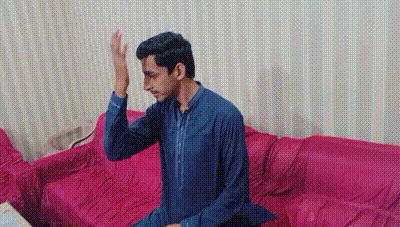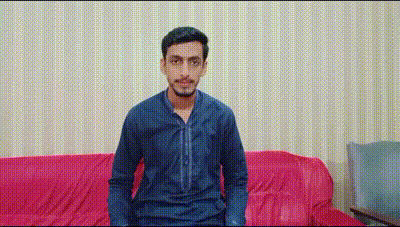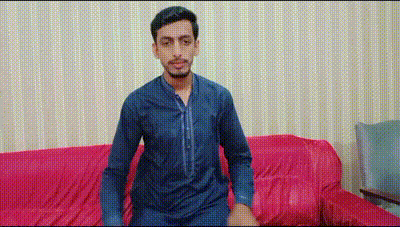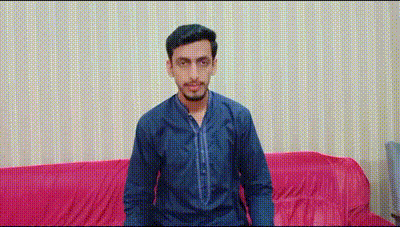Hello Everyone
I'm AhsanSharif From Pakistan
Greetings you all, hope you all are well and enjoying a happy moment of life with steem. I'm also good Alhamdulillah. |
|---|

Design On PosterMyWall
What's Cervical Radiculopathy? Write in your own words after getting knowledge from the lesson post. |
|---|
Cervical Radiculopathy
Cervical radiculopathy is a disease or condition in which a nerve in the neck gets compressed or irritated. As a result, we become very weak, feel numb, and feel pain, and the disease spreads to the arms or hands.
Usually, this disease or condition is due to old age or we may face similar conditions in case of injury. Due to this problems such as degenerative changes in the spinal cord occur. Cervical people can usually experience a lot of neck and upper body pain in this condition.
In such a condition, we find it very difficult to use our arms or our fingers. It depends on which nerve is affected by it.
Reasons:
This state is formed based on some of our reasons and those are the main reasons:
Among the main reasons, the first reason is that the disc in our spinal cord ruptures. When a nerve is pinched it causes it to burst. Due to this, we have to face such a disease.
As we get older, the extra bone growth caused by aging can compress nerves.
Nerve compression occurs in our body when the disc in our spinal cord expires. Because it wears off with time, we still face this condition.
Symptoms:
In such a condition we feel a lot of pain in the neck. And that pain gradually spreads from our shoulders to our arms and hands.
In such a situation, what is affected by us, for example, our arm is affected. In this arm, we feel the sensation of pins and needles.
The muscles in the affected part of our body become weak due to which we find it difficult to hold or lift anything.
It is such a condition that it can damage both our arms due to which we can face a lot of difficulties, but it depends on which nerve it has pressed. We often become aware of this as we age or when our body suffers an injury that affects the spinal cord.
Treatment:
For its treatment, we have to adopt a simple method as first of all, we have to rest our bodies. Along with rest, we will have to do physical therapy so that we can improve ourselves. And likewise, we have to use medicine for whatever pain and inflammation we have. When the condition is too severe, we have to go for surgery to relieve the pressure on our nerves.
How would you diagnose a Cervical Radiculopathy? Any clinical investigation or assessment tests? |
|---|
Generally, the steps involved in how this condition is diagnosed are as follows:
Medical History and Symptoms Review:
In such a situation, the first doctors ask us about our symptoms. The first symptom among these symptoms is that they ask us about the pain, at which point we are feeling the pain. Where is the pain felt in such things as the neck, shoulder, arm, or hand?
Also, they ask us if we feel any kind of numbness. Or muscle weakness which we can call or feel like tingling. They will then explore when the symptom started in your body and what is causing the obstruction, what is causing the problem in your movement.
Physical Examination:
The doctor will then do a physical exam to assess your neck, arms, and hands, including these:
- He will then move your neck to different angles to determine if the pain is dynamic or if the pain is caused by movement.
- He will then test your body's arm and hand muscles to see if they are strong or have any weakness.
- Then tap on the tendon to check if your reflexes are slow or absent.
- He will then examine the affected area where you feel numbness or tingling.

Pixabay
Specialized Clinical Test:
Doctors use different tests to identify the cervical radiculopathy:
Spurling's Test: With this test, the doctor will bend your body downwards and apply slight pressure on it. In this case, if it causes pain anywhere under your arm, it suggests nerve compression.
Shoulder Abduction Test: Doctors recommend raising your arms above your head to assess the nerves on which you feel the irritation, which makes the symptom clear.
Cervical Distraction Test: In this test, doctors hold our head and pull it slightly to see if the pain is reduced or increased. If the pain is reduced, it is an indication that nerve pressure may be causing the problem.
Imaging Test:
If clinical signs point us to cervical radiculopathy, then we order imaging studies to evaluate it, including the following:
X-ray: With X-rays, we can see where the space is narrowed, like a nerve exiting the spinal cord.
MRI: MRI, which stands for Magnetic Resonance Imaging, is a common test used to diagnose the cervix. This gives us a picture of what is causing the spinal cord or any herniated disc or other nerve compression problem.
CT Scan With Myelography: It is used when an MRI is not available. This involves injecting a contrast dye into the spinal canal to highlight the nerve roots.
EMG:
EMG stands for Electromyography. If doctors are not giving their confirmation in such a situation then they use these tests for that. They measure how well electrical signals are traveling in nerves and muscles.
Try to practice at least 3 exercises that you have learned from the lesson. Share images, gifs, or videos while practicing. |
|---|
Isometric Neck Flexion

Isometric Cervical Rotation

Isometric Neck Extension

Isometric Neck Retraction

Share your review after performing these exercises either on yourself, a healthy individual, or a patient. |
|---|
Isometric Neck Flexion:
This exercise targets the muscles in the front of my neck which makes me feel better. Because it is the best exercise for us when we have to do a lot of work sitting or looking down. Much better for relieving neck tension. I give this a great review. Be sure to include your core to maintain proper alignment.

Isometric Cervical Rotation:
This exercise strengthens our head rotator muscles and is very beneficial in our neck movement. Holding our neck in this position without movement builds endurance in our neck muscles, which gives us a great advantage for repeated head turns. This is often the position we have to take when we are playing a game or we are driving. With this exercise, we can strengthen our muscles for these activities. I am a sportsman myself so being a sportsman this exercise has been very good for me.

Isometric Neck Extension:
This exercise has been very beneficial for me because I also use my computer and mobile for long periods of time while sitting, which causes back pain, so this exercise has helped the back of my neck. The muscles are improved. Because of this, it gives me the strength to keep in a neutral position. This is often to relieve pressure on the top of my spine.

Isometric Neck Retraction:
This exercise is very useful for relieving shoulder tension that works the muscles at the base of the skull and upper back. This exercise has proven to be very effective in improving an overall posture by aligning the head with the spine of our body.

Overall if I talk then all these exercises are very perfect for our body. Through them, we can relieve the pain in our neck and the nerves around the neck. This is an easy way to relieve your pain.
Thank you so much guys for staying here. I would like to invite my friends @ruthjoe, @josepha, @bossj23, and @suboohi to join this challenge.
| Camera | Oppo F15 |
|---|---|
| Editor | Inshot |
| Gif Maker | Free Convert |
Cc:
@ashkhan

X:
https://x.com/AhsanGu58401302/status/1856273095977521322
Downvoting a post can decrease pending rewards and make it less visible. Common reasons:
Submit
Thank you for understanding the lesson and sharing your assignment; I hope that you will enjoy this week's lesson and try to implement it in your life if you see any such case.
Observations
Task 1 (2.7/3)
You have shared a good knowledge about cervical radiculopathy, and it's cause, symptoms, treatment, but you have add also the vertebrae involve in cervical radiculopathy. A bit more depth require to complete the answer. I appreciate your effort.
Task 2 (2.9/3)
In the second question, you tell us about how you have to assess a patient by doing the physical examination, history taking, investigations of patients and specialized tests. You have share good knowledge but the best test for nerve examination is NCS nerve conduction study test. Great.
Task 3 (2.5/4)
You try the isometric neck rotation, extension, flexion and retraction. But while performing Isometric flexion and extension you have to apply resistance & apply that much force that didn't allow head movement. But in these gifs you are freely allowing movement of head with hand. Remember always apply heating pad to relax your muscles before performing these exercises. I appreciate your efforts.
Overall you made a great attempt to answer all the questions except question 3. I appreciate your efforts. But next time try to avoid the above written suggestions. Keep learning and try to implement your knowledge to the people suffering from any cervical radiculopathy. Thank you.
Downvoting a post can decrease pending rewards and make it less visible. Common reasons:
Submit
Thank you so much for the verification and the valuable feedback. I try my best to complete my next task.
Downvoting a post can decrease pending rewards and make it less visible. Common reasons:
Submit